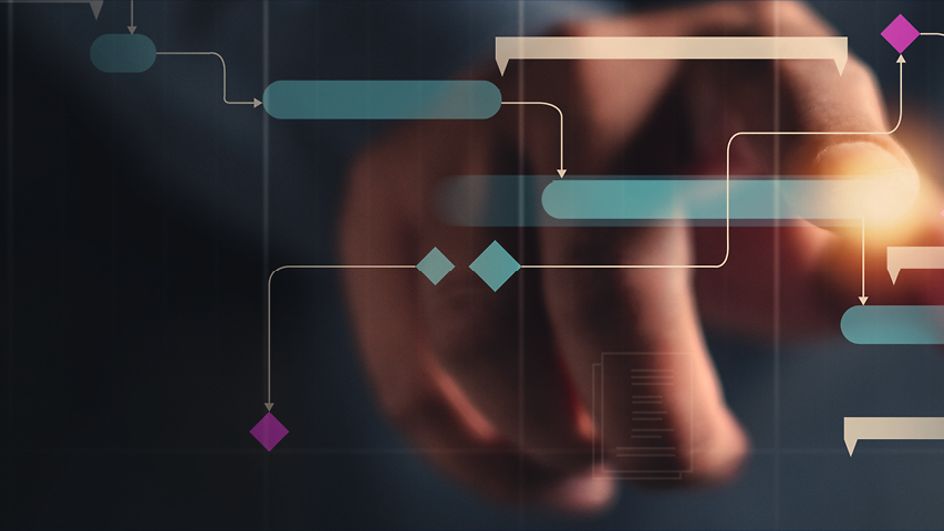With Digital Workflows Towards More Efficient Work Methods
Article: "Where are the bottlenecks?" – How Deutsche Bahn's procurement brought more transparency into its acquisitions
04/2025 – Efficient digital processes thanks to new workflows and a supportive tool. The 'General Procurement' division of Deutsche Bahn, together with its IT specialists and DB Systel, has designed procurement processes that are unified and more transparent for all stakeholders.
In a large infrastructure company like Deutsche Bahn, there’s always something needed – from pencils, licenses for new software, to switches and high-speed trains. In total, Deutsche Bahn's strategic procurement handles approximately 5 billion euros worth of acquisitions annually. The speed, transparency, and efficiency of procurement are vital factors for how well the company can prepare for future challenges.
Thanks to a new process tool based on the low-code platform of its strategic partner Pegasystems and new workflows, these processes are now more efficient, transparent, and standardized. To achieve this, the corporate procurement team, together with DB Systel, reimagined the entire process chain and brought it into implementation in collaboration with employees. The status and progress of each process are now transparent to all participants: everyone involved can see the current position of a transaction at any time. Additionally, the company now gets the overarching insights required to manage strategic changes resulting, for instance, from the S3 program.
The Role of Procurement at Deutsche Bahn
When Deutsche Bahn needs something, its corporate procurement handles price negotiations and ensures the requirements of individual departments are met. Procurement consists of multiple departments and roughly 1,000 employees. The "General Procurement" division oversees everything at Deutsche Bahn that doesn’t pertain to vehicles or infrastructure. "Everything you see in an office around you comes from General Procurement," explains a representative, who also led the software and process project for the 250 employees in General Procurement. This person specializes in IT personnel procurement at Deutsche Bahn.
Deutsche Bahn's procurement team regularly deals with complex tenders and awarding procedures. Internal corporate policies and external regulations, such as the Supply Chain Act, impose stringent requirements on their work. Procurement law and antitrust law frequently apply, along with subsidy rules that dictate appropriate handling of grants.
"We had to recognize that despite these extensive requirements, much of our work was still happening verbally or via email," explains the representative.
Bringing Transparency to Complex Processes
Historically, the specific procedures for implementation weren’t always uniform. "Even within individual procurement teams, things were done differently," says the representative, describing the past. These manual, inconsistent processes worked but had drawbacks: "We sometimes experienced significant turnaround times," they recall, "partly because we were acting on behalf of 'need owners' as buyers."
Transparency between departments was often lacking. For example, the "need owners," such as the department requesting new materials, were not consistently involved. Similarly, management, responsible for signing off orders, would only learn the details at the end of the procurement process and might raise questions. "Where are we at? What’s causing delays?" used to be typical questions within the procurement team.
When staff were on vacation or onboarding new employees, the absence of defined standards was also a barrier. For employees, it also meant additional effort to provide transparency over transactions. "Procurement specialists had to not only process contracts but also provide transparency for management, for instance by filling out Excel spreadsheets – which was hardly part of their core tasks," explains Felix Jäger, Product Owner of DB AG’s Procurement Tools & Documents (Proflows) team. His team drives the digitalization of procurement processes within the company. Michael Boback, Head of IT-Systems Procurement at DB AG, emphasizes that digitalizing these processes reduces the workload for employees and significantly increases the efficiency of the overall procurement process.
"We’ve been successfully using Pega for several years. The workflows sustainably enhance the efficiency of procurement performance processes and support our customers' goals. Pega has therefore become an integral part of our IT strategy."

Delivering a New Practice in Just a Few Months
In 2019, Deutsche Bahn decided to streamline its General Procurement processes into standardized workflows supported by a unified tool. This project, called "Source2Contract," aimed to map the entire procurement lifecycle – from vendor selection to final contract signing – within a single solution.
Recalling the pace of progress, a representative shares: "We kicked off in April 2020. Nine months later, we ran the first trials in my department." The momentum continued: "Three months later, the entire IT procurement team was using it productively. Six months after that, so was the whole General Procurement team." The representative believes the flexibility of workflow tools like Pega, with its low-code approach, can enhance process efficiency beyond traditional enterprise tools like SAP.
"This was an incredibly complex process. Within less than 1.5 years, we developed an application that met all our needs. I’ve never seen anything like it – and I’ve been in IT for a long time."

A Holistic Team Approach for Success
DB Systel was involved from the start, joining even before the tool selection decision was finalized. "It was very telling that everyone – even the employees executing these processes – took part in early workshops," recalls Dirk Böning-Corterier of DB Systel. This early and close collaboration was a critical factor in the project's success and helped foster trust across divisions.
The practical and technical implementation succeeded at a rapid rate due to the close cooperation of all stakeholders: the procurement representatives, Felix Jäger’s team, and DB Systel formed an agile project team working seamlessly together: "Roles blurred; people barely noticed who came from which company."
A New Process Design for Everyday Tasks
One key realization during the project was that corporate regulations describe end results but not necessarily the path to reach them. The Pega workflows now provide guidance to achieve those results in the most efficient way.
This transformation was more than just a digitalization effort – it redefined work methods within Procurement. New standardized actions and tighter communication fundamentally changed work habits, which wasn’t always easy for all employees. Successfully supporting colleagues through these changes was as important as meeting the technical requirements.
"The implementation wasn’t just about introducing IT; it was primarily about creating a unified vision for the process. It started small to gather feedback and scale from there. Ultimately, it was about helping people adapt to new ways of working."

Standards and Transparency for Corporate Strategy
"Unified work practices are a key theme we're implementing across the corporation," emphasizes Böning-Corterier. Employees now follow standardized workflows that are easier to learn. The system’s step-by-step guidance improves training and coverage during absences – critical factors amid today’s skilled labor shortages.
All stakeholders are involved from the beginning of each procurement, can view progress at any time, and address questions promptly. Additionally, cross-departmental analyses now provide insights previously available only with significant effort. Regulatory requirements are seamlessly integrated into workflows: the system elegantly guides employees through the maze of bureaucracy.
This new transparency and efficiency are especially valuable for strategic decisions and key corporate programs. "What would’ve happened had we approached today’s strategic changes with the old processes?" ask Volker Muhr and Dirk Böning-Corterier. "We now have full transparency and much better grounds for discussions on what to improve going forward."


